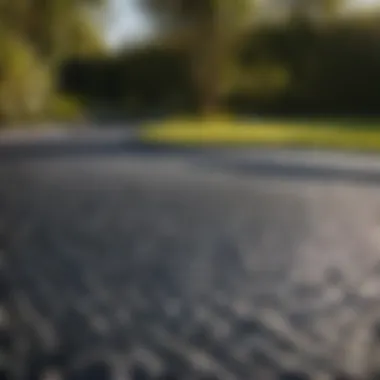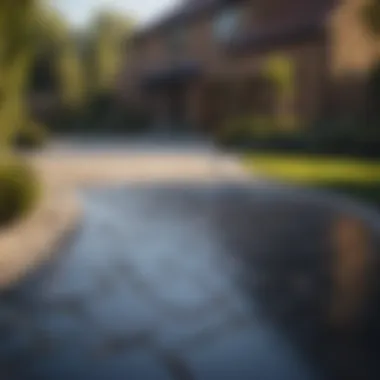Materials:
- Tar stone driveway kit
- Gravel
- Sand
- Tar stone mix
- Weed barrier fabric
- Edging material (e.g., bricks, timbers)
- Hand tamper
- Plate compactor
- Wheelbarrow
- Shovel
- Level
DIY Steps:
- Prepare the Area: Excavate the current driveway surface to the desired depth to accommodate the tar stone driveway.
- Compact the Base: Fill the excavated area with gravel and sand, compacting it with a hand tamper and plate compactor for a stable base.
- Apply Weed Barrier: Lay down weed barrier fabric to prevent weed growth through the driveway surface.
- Edging Installation: Install edging material around the perimeter of the driveway area to contain the tar stone mix.
- Mix and Apply Tar Stone: Prepare the tar stone mix as per the kit instructions and apply it evenly onto the driveway surface.
- Compact and Level: Use a plate compactor to compact the tar stone mix and ensure a level finish.
Technical Aspects:
- Tools: Ensure you have a hand tamper, plate compactor, level, and shovel for the installation.
- Timing: Plan the installation on a dry day to prevent moisture interference.
- Critical Techniques: Proper compaction and leveling are essential for a durable and aesthetically pleasing tar stone driveway.
DIY Project Process:


- Follow the sequence of excavating, compacting, applying the base layers, installing edging, mixing and applying tar stone, and finally compacting and leveling for a finished driveway.
Troubleshooting Tips:


- If the surface appears uneven after compacting, add additional tar stone mix and repeat the compacting process for a smoother finish.
Introduction


Tar stone driveways have become an increasingly popular choice for homeowners seeking a durable and visually appealing alternative to traditional driveway materials. This article aims to provide a comprehensive guide on tar stone driveways, covering various aspects such as installation processes, maintenance tips, and environmental impact. By delving into the intricacies of this unique driveway option, readers can gain a deeper understanding of its benefits and considerations.
Understanding Tar Stone Driveways
Composition of Tar Stone
One of the key elements of tar stone driveways is their composition, which typically includes a mixture of bitumen and aggregates. This combination results in a robust and hard-wearing surface that can withstand heavy traffic and harsh weather conditions. The flexibility of tar stone allows for better adherence to the underlying surface, reducing the chances of cracking and shifting. This unique feature makes tar stone driveways a popular choice for homeowners looking for longevity and durability in their driveway material.
Advantages Over Traditional Driveways
Tar stone driveways offer several advantages over traditional driveway materials such as concrete or asphalt. One significant advantage is their ability to adapt to varying terrain and climates, providing a stable and resilient surface regardless of environmental factors. Additionally, tar stone driveways require less maintenance than traditional options, saving homeowners time and effort in upkeep. The flexibility of tar stone also allows for easier repairs in case of damage, ensuring a longer lifespan for the driveway.
Environmental Considerations
When considering environmental impact, tar stone driveways offer eco-friendly attributes. The composition of tar stone typically involves recycled materials, reducing the overall carbon footprint of the driveway. Additionally, the longevity of tar stone driveways means less frequent replacement compared to traditional options, further contributing to sustainability.
Installation Process
Site Preparation
Prior to installation, thorough site preparation is crucial for ensuring a stable and long-lasting tar stone driveway. This includes leveling the area, removing debris, and addressing any drainage issues to prevent water accumulation. Proper site preparation lays the foundation for a smooth and structurally sound driveway surface.
Material Mixing and Application
The process of mixing and applying tar stone involves precise measurements and a careful blending of bitumen and aggregates. This meticulous approach ensures uniformity in texture and consistency, resulting in a visually appealing and functional driveway surface. The proper application of the tar stone mixture is essential for achieving optimal results in terms of durability and aesthetics.
Curing Period
After the tar stone mixture is applied, a curing period is necessary to allow the material to set and harden. This curing period varies depending on factors such as temperature and humidity. Proper curing is critical for ensuring the strength and resilience of the driveway surface, enabling it to withstand regular use and environmental stressors.
Maintenance Tips
Regular Cleaning Practices
Maintaining a clean tar stone driveway involves regular sweeping to remove debris and dirt buildup. Periodic washing with water and mild detergent can help preserve the appearance of the surface and prevent staining. Regular cleaning practices not only enhance the aesthetic appeal of the driveway but also contribute to its longevity.
Repairing Cracks and Potholes
Over time, tar stone driveways may develop cracks or potholes due to wear and tear. Repairing these imperfections involves filling them with a compatible tar mixture and ensuring proper compaction. Timely repairs can prevent further damage and prolong the lifespan of the driveway.
Sealing Recommendations
Sealing the surface of a tar stone driveway is recommended to enhance its water resistance and protection against UV rays. Sealants help maintain the integrity of the driveway surface, reducing the risk of deterioration from exposure to elements. Regular resealing at recommended intervals can safeguard the driveway against premature wear and damage.





